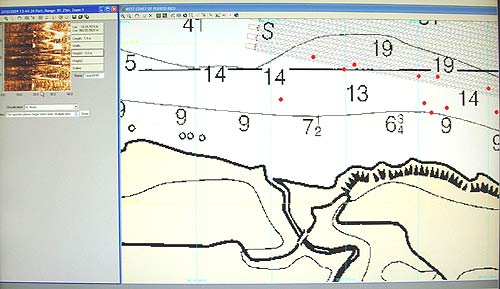On Board the OSV BOLD: Back to the Science
Posted on February 11th, 2009 - 3:00 PM| For more than a month, EPA’s Ocean Survey Vessel (OSV) Bold is studying the health of the waters around Puerto Rico and the U.S. Virgin Islands. EPA scientists and non-scientists will blog about their research and what it’s like to live and work at sea. |
February 11, 2009 - 1:20 pm (Day 3)
About the Author: Beth Totman is a press officer in Region 2, New York City. She covers Superfund, Emergency Response and Pesticides. She’s been with EPA since June 2007.
After a crazy and turbulent day at sea yesterday, this morning brought in sun and blue skies…a calm after our day long search, which ended well past midnight in 60mph winds and over 15 foot waves. Despite the conditions yesterday, EPA was able to composite crucial data and information that Doug will use to report back to the Puerto Rico Search and Rescue squad and the U.S. Coast Guard. Without the OSV BOLD’s side scan sonar capabilities, the search and recovery divers would search the ocean floor, as if they were searching for a needle in a haystack. Today, armed with the information that was acquired by the side scan sonar technology on the OSV BOLD, those divers now have an extra pair of eyes to search for the plane debris in the depths of the Caribbean Sea.
It was incredible to witness how quickly and effectively Doug and his team worked to get EPA’s search and recovery mission underway. Morale was high as the ship left San Juan harbor at 06:00 and charged on to the west. Doug had put together a grid of where the OSV BOLD would be searching and he did so through information from the Coast Guard and eyewitness accounts of where the plane went down. I tried to help in whatever way I could, but mainly just tried not to get in the way. The scientists and crew worked around the clock to visually search the side scan sonar that came in in real-time in the lab for anything that looked man-made on the bottom of the ocean floor.
As a result of yesterday’s work, Doug and his team of scientists have put together an extensive report that spells out what the side scan sonar found yesterday, and EPA is aware that if the weather continues to improve, making for better conditions for the side scan sonar technology to run at full capacity, we may have to return to the northwest coast of Puerto Rico. EPA has made it well-known that the OSV BOLD is on call. But until that call, we will continue on with our initial itinerary.
 Screenshot of side scan sonar and map indicating possible man-made targets (red dots) EPA found and passed on to US Coast Guard and authorities in Puerto Rico. Screenshot of side scan sonar and map indicating possible man-made targets (red dots) EPA found and passed on to US Coast Guard and authorities in Puerto Rico. |
Tomorrow, the OSV BOLD will be on open display to the public and the press. EPA will be giving tours of the ship to better communicate how important this incredible ship is in reaching EPA’s goals of protecting our oceans—and in using Her state-of-the-art technology to help out in impromptu search and rescue missions. With such an interesting start to our trip, it will be nice to open the ship up to outsiders who only have a vague idea of what She is all about. The press down here have reported on EPA’s role in yesterday’s search and recovery efforts, and we are ready to showcase the technology and importance of this ship to the public that we serve.
Tags: BOLD Research Vessel
| Permalink | TrackBack
February 12th, 2009 at 9:54 am
Hello, I can’t understand how to add your blog in my rss reader. Thank you.
[Reply]
Jeffrey Levy reply on February 12, 2009 10:17 am:
Hi there. Our RSS feed is at http://blog.epa.gov/blog/feed/
You can find a link to it on the top right side of each blog page.
Thanks!
Jeffrey Levy
Greenversations team
[Reply]
Paul C reply on February 12, 2009 1:40 pm:
Thank you for your fast answear.
[Reply]